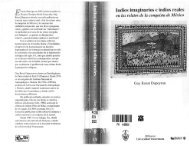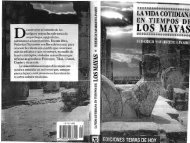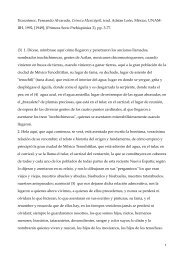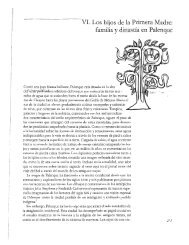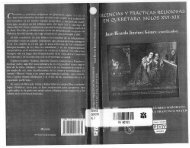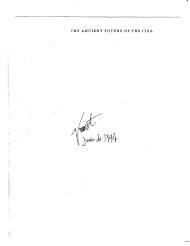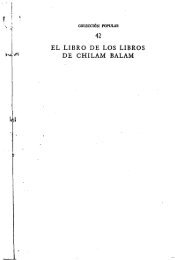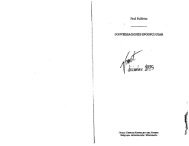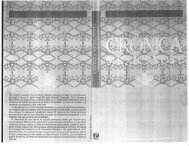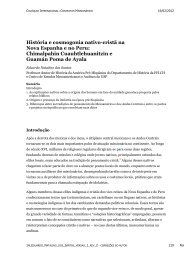HEAVEN BORN MERIDA AND ITS DESTINY - Histomesoamericana
HEAVEN BORN MERIDA AND ITS DESTINY - Histomesoamericana
HEAVEN BORN MERIDA AND ITS DESTINY - Histomesoamericana
Create successful ePaper yourself
Turn your PDF publications into a flip-book with our unique Google optimized e-Paper software.
î6<br />
INTRODUCTION<br />
conquest, though only some of them are mentioned in the Chumayel:<br />
Chakan, Chikin Ch'el, Cozumel, Ecab, Uaymil, Tutul Xiu, and Chable.<br />
It can hardly be coincidental that the number of provinces matches the<br />
number of uinals in the tun, but this fact does not appear to be particularly<br />
stressed. The Maya called Yucatan the Ordered Country, the Land of<br />
the Ceiba, or the Four-Part Country (the fifth part was the center). The expression<br />
Cycle Country [mayab], which occurs elsewhere, does not appear<br />
in the Books, nor does the expression Land of the Deer and Pheasant.<br />
If my surmise that there were 13 numeral prefixes for cities is correct, all<br />
the major cycles of the calendar (4, 5, 13, and 18) may have been projected<br />
onto Mayan geography. It is not clear how 7, 9, and 20 figured in, but they<br />
must have been involved somehow terrestrially as they were cosmologically.<br />
After all, Yucatan was the Ordered Country [tzol peten).<br />
The place-names mentioned in the Chumayel are listed in the index,<br />
and a ritual gazetteer of 171 of them will be found in chapter 12 and<br />
appendix B.<br />
Onomastics. The Yucatecans do not appear to have used the naming<br />
system, based on the uinal, that was employed throughout Middle America<br />
to name individuals. They knew about it, of course, but the only<br />
example in the Chumayel is Nahuat: Five Flower. This appears in both<br />
Nahuat and Maya (Macuilxuchit, Ho Nicte), but Flower is not a day name<br />
in Maya. The naming of persons in Yucatan was almost entirely a matter<br />
of lineage.<br />
A proper name in Maya was always binary: it was composed of a maternal<br />
patronymic and a paternal one, in that order. Thus Yax Chuen's<br />
mother's father was a Yax and his father was a Chuen. Patrilineages were<br />
the basic units of Mayan society, and they were rigidly exogamous. If Yax<br />
Chuen's wife were Ek Balam, their children would be named Balam Chuen.<br />
They would be eligible to marry someone named Yax Ek or Ek Yax, including<br />
their first cross-cousins, but they could not marry a Chuen or a<br />
Balam. Sometimes the name was preceded by the word Na 'mother', as<br />
in Na Tzin Yabun, but that was not mandatory. It may indicate cases in<br />
which the maternal patrilineage had higher status.<br />
Having all one's siblings running around with the same name presented<br />
obvious problems. These were solved by adding titles, usually prefixed,<br />
and nicknames, usually suffixed, as in Ah Kin Na Ahau Pech Chan 'the<br />
sun priest (mother) lord tick the younger' (the example is a hypothetical<br />
composite) or Uayom Ch'ich' Chich 'sleeping bird the strong' (lines 695-<br />
696). Sometimes the order of elements was inverted, as in Kin Ich Kak Mo<br />
'sun face fire macaw' or Kukul Can Ah Nacxit 'quetzal snake priest of<br />
Four Leg'. Proper names were sometimes inflected, particularly the maternal<br />
patronymic, taking the suffix -VI or -il, as in Yaxal Chac, Kukul Can,<br />
or Ulil Ahau. This may have been primarily for euphony and clarity of<br />
enunciation.<br />
A number of the 150 to 200 recorded lineage names were common to<br />
the Xiu and the Itza: Ahau, Amayte, Ay, Chac, Coc, Itzam, Kak, Kau,<br />
Mo, Puc, Zac. Others were not. The Xiu frequently had Nahuat names:



